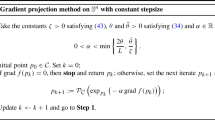Abstract.
Our concern lies in solving the following convex optimization problem:where P is a closed convex subset of the n-dimensional vector space X. We bound the complexity of computing an almost-optimal solution of G P in terms of natural geometry-based measures of the feasible region and the level-set of almost-optimal solutions, relative to a given reference point x r that might be close to the feasible region and / or the almost-optimal level set. This contrasts with other complexity bounds for convex optimization that rely on data-based condition numbers or algebraic measures, and that do not take into account any a priori reference point information.
Similar content being viewed by others
References
Freund, R.M.: On the primal-dual geometry of level sets in linear and conic optimization. SIAM J. Optimization, to appear
Freund, R.M., Vera, J.R.: Condition-based complexity of convex optimization in conic linear form via the ellipsoid algorithm. SIAM J. Optimization 10(1), 155–176 (1999)
Freund, R.M., Vera, J.R.: Some characterizations and properties of the ‘‘distance to ill-posedness’’ and the condition measure of a conic linear system. Math. Programming 86, 225–260 (1999)
Grötschel, M., Lovasz, L., Schrijver, A.: Geometric Algorithms and Combinatorial Optimization. Springer-Verlag, Berlin, 1988
Nesterov, Y., Nemirovskii, A.: Interior-Point Polynomial Algorithms in Convex Programming. Society for Industrial and Applied Mathematics (SIAM), Philadelphia, 1994
Renegar, J.: Some perturbation theory for linear programming. Math. Programming 65(1), 73–91 (1994)
Renegar, J.: Linear programming, complexity theory, and elementary functional analysis. Math. Programming 70(3), 279–351 (1995)
Renegar, J.: A Mathematical View of Interior-Point Methods in Convex Optimization. Society for Industrial and Applied Mathematics, Philadelphia, 2001
Ye, Y.: Toward probabilistic analysis of interior-point algorithms for linear programming. Math. Operations Res. 19, 38–52 (1994)
Yildirim, E.A., Wright, S.J.: Warm-start strategies in interior-point methods for linear programming. SIAM J. Optimization 12(3), 782–810 (2002)
Author information
Authors and Affiliations
Corresponding author
Additional information
Mathematics Subject Classification (2000): 90C, 90C05, 90C60
This research has been partially supported through the Singapore-MIT Alliance. Portions of this research were undertaken when the author was a Visiting Scientist at Delft University of Technology.
Received: 1, October 2001
Rights and permissions
About this article
Cite this article
Freund, R. Complexity of convex optimization using geometry-based measures and a reference point. Math. Program., Ser. A 99, 197–221 (2004). https://doi.org/10.1007/s10107-003-0435-1
Accepted:
Published:
Issue Date:
DOI: https://doi.org/10.1007/s10107-003-0435-1




